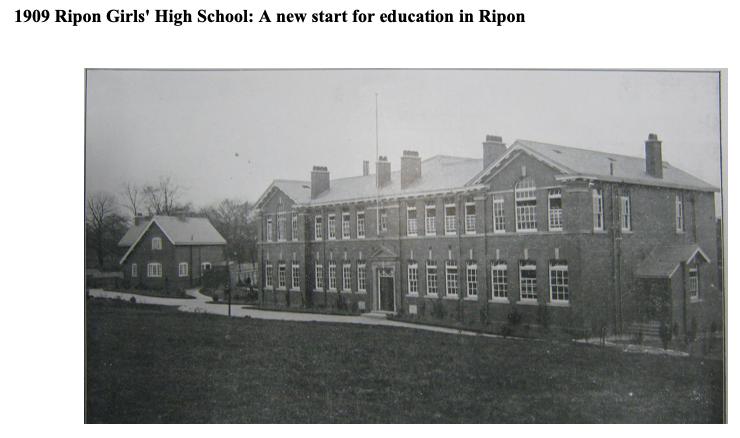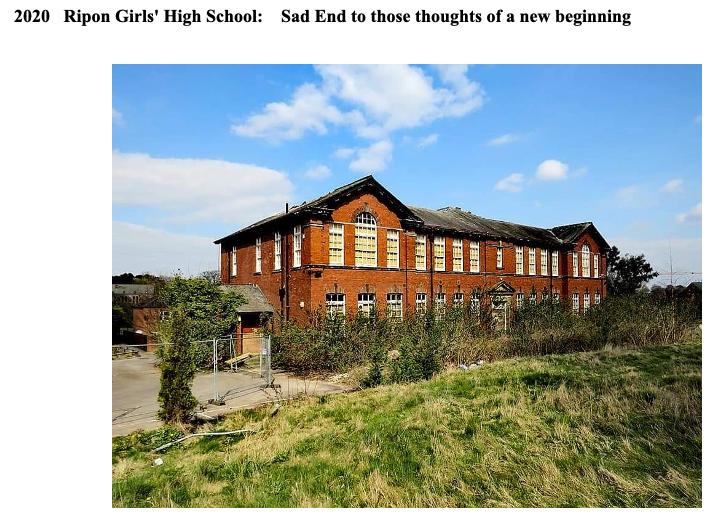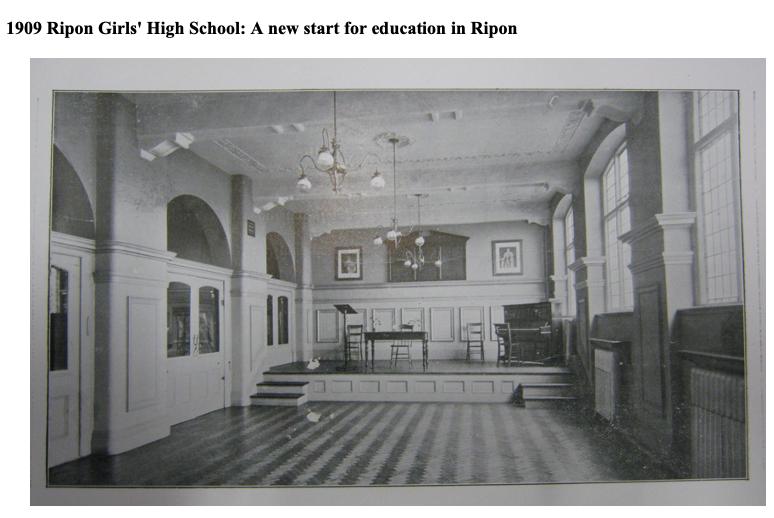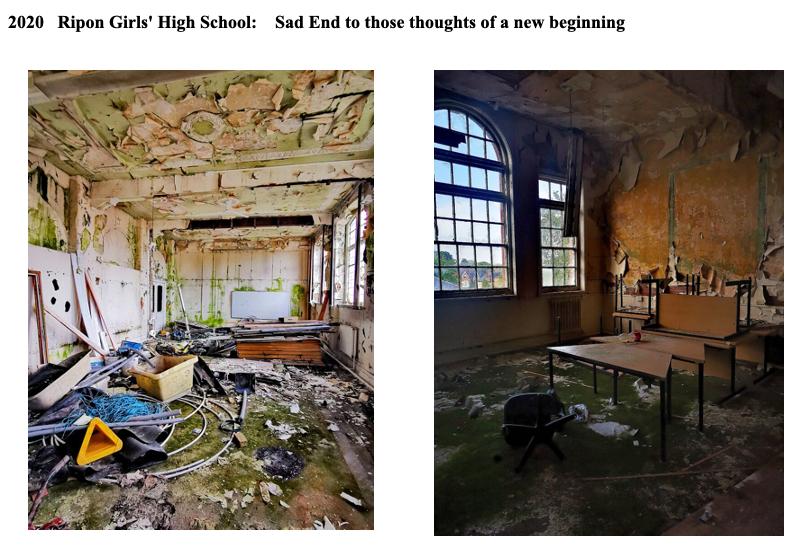Joining together in a brave new world
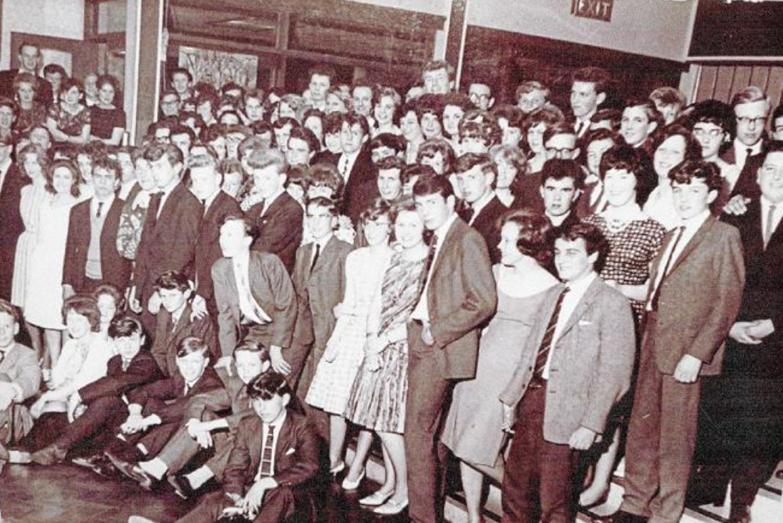
This year, we mark the sixtieth anniversary of the amalgamation of Ripon Grammar School (RGS) and the Ripon Girls' High School (RGHS) with a reunion on July 17 at school, from noon, to include school tours, an exhibition in the library and an Old Rips v RGS cricket match
AT the end of 1962/63, an article in The Riponian declared: "We wondered how we could survive, yet here we are unscathed. To some extent, of course, the two former schools retain their separate identities and this is only right and proper at this stage.
"Many, however, are already hobnobbing with the enemy, some with amazing courage and forwardness, while for those who are not, or who require refuge from the fray, retreats have been provided: there is the lower field where the boys can enjoy their private and muse nostalgically over the good old days, ruing the loss of male superiority, now, alas, gone forever: and, for the girls, there is the area about the tennis courts, a place where they may knit, commune with nature, learn deportment or engage in other mysterious feminine pursuits."
We look at school life in the Sixties, below, and follow the history of RGHS, from its founding in 1909 to its amalgamation with RGS in 1962
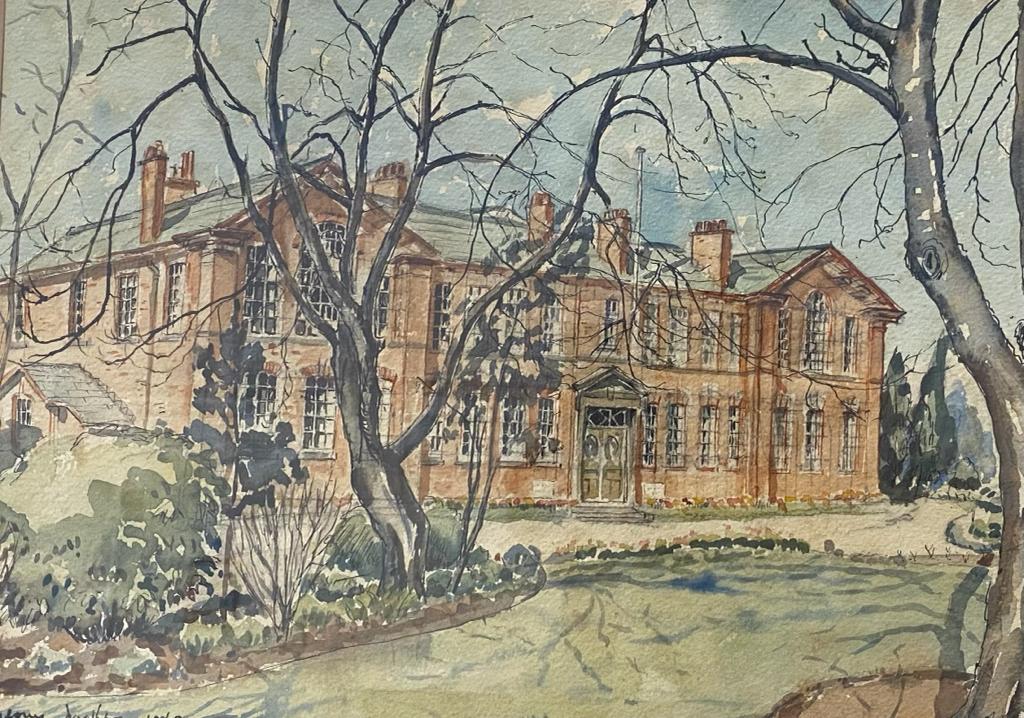
1960s: That Was the Decade That Was
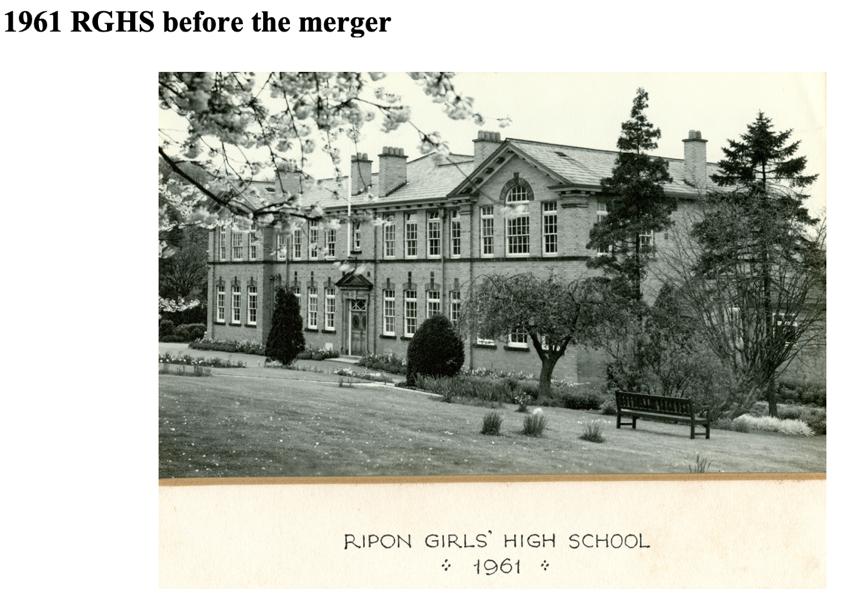
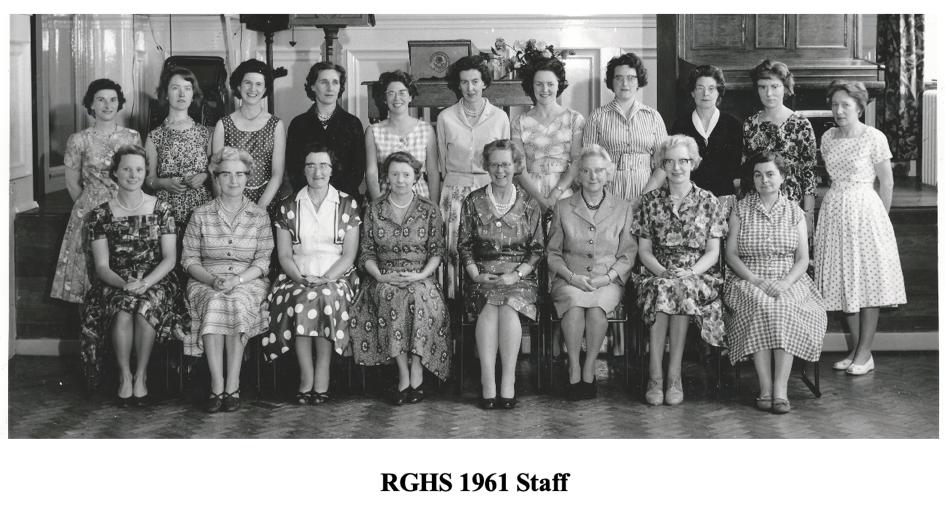
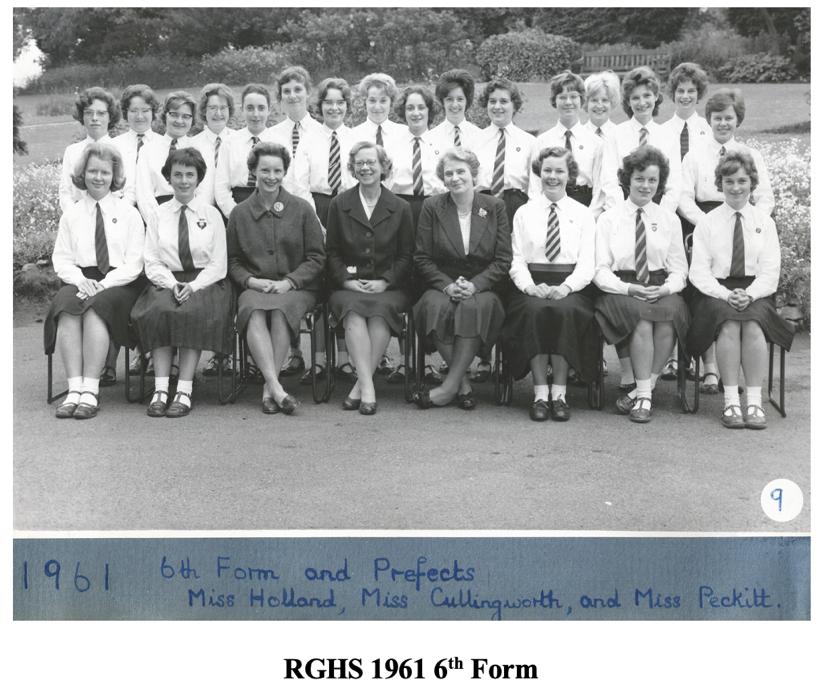
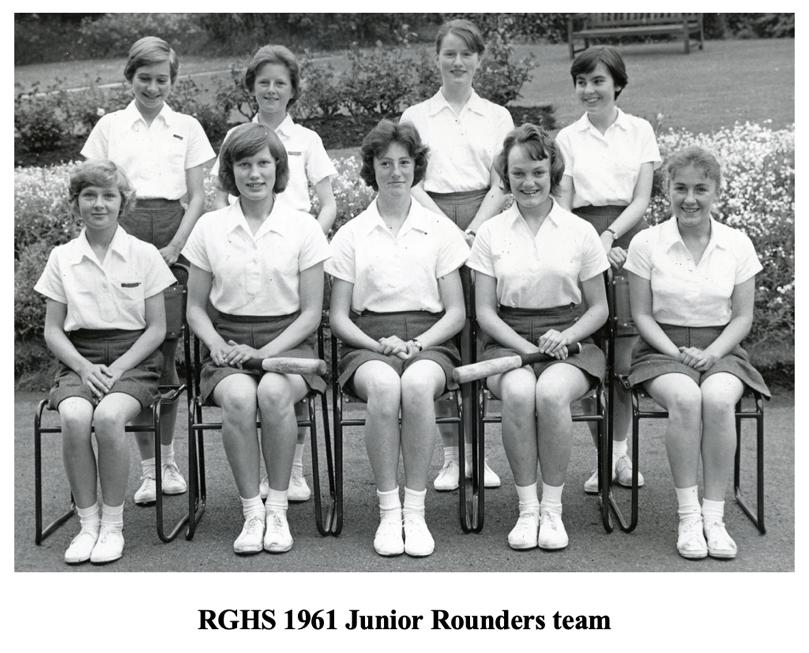
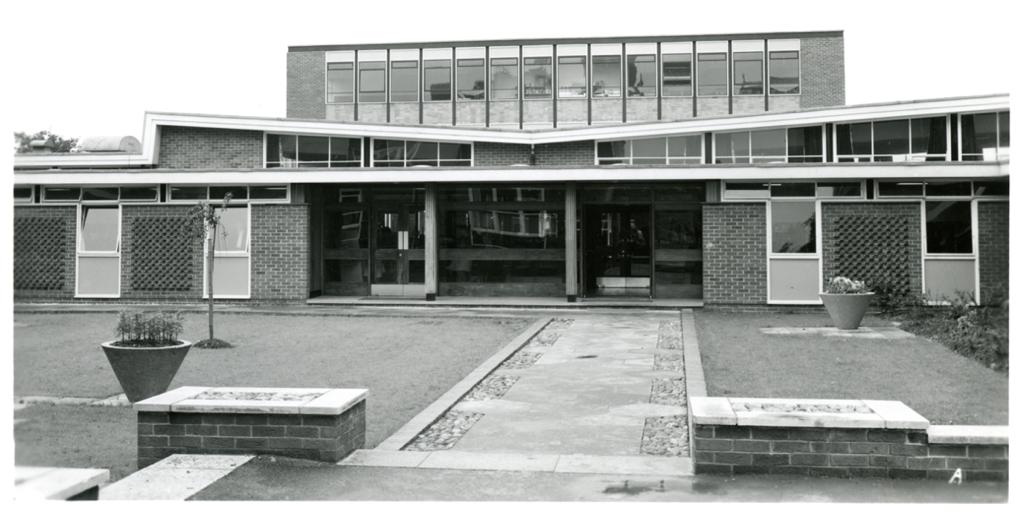
1962: A brave new world - the merger
Extract from The Riponian magazine 1962 – 1963
EDITORIAL: Inevitably this has been a year of adjustment, a time for settling in and for quietly establishing new traditions on the foundations of the old. However, the delicate process of grafting the new school on to the old has passed with remarkably little friction and has left no scars, at least none visible, for even those who regarded the amalgamation with trepidation have been surprised by the comparative ease and painlessness of the operation.
We wondered how we could survive, yet here we are unscathed. To some extent, of course, the two former schools retain their separate identities and this is only right and proper at this stage. Many, however, are already hobnobbing with the enemy, some with amazing courage and forwardness, while for those who are not, or who require refuge from the fray, retreats have been provided: there is the lower field where the boys can enjoy their private and muse nostalgically over the good old days, ruing the loss of male superiority, now, alas, gone forever: and, for the girls, there is the area about the tennis courts, a place where they may knit, commune with nature, learn deportment or engage in other mysterious feminine pursuits.
As for the building, if all there is not quite sweetness and light, it would be churlish not to be grateful for the new conveniences, especially for the splendidly stocked and tastefully furnished library, the fine stage, magnificent gymnasium and swimming baths, and, for those resident, the luxurious new house for girls and the renovated boys' boarding house, a far cry from the old Dickensian horror.
We have much to be thankful for and some cause for mutual congratulation, though none for complacency. What seems to be needed most, in fact, is a sense of challenge and a greater spirit of determination.
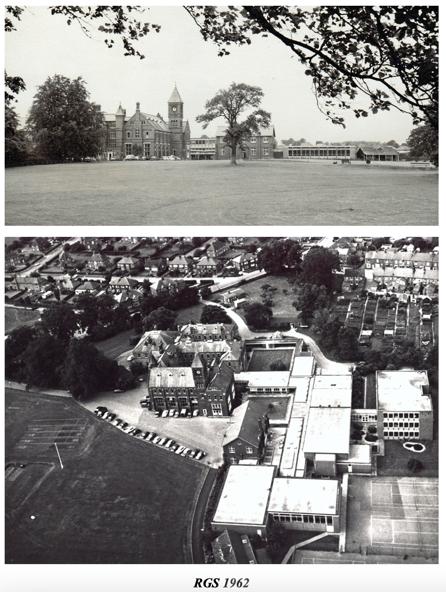
Extract from the RGHS Magazine 1962
THOUGHTS on the amalgamation and leaving RGHS from Carol Stocks (sixth form)
"To me, the amalgamation and. leaving school mean nothing as yet. I know that the new buildings at the grammar school will house a large, new co-educational school. I know that I will go to training college next September, but the hard fact that the high school will no longer be in existence has made no real impact on me yet.
"When we are at school, we often say that we dislike everything about it, the actual building, school dinners, homework, lessons, but I am sure that the memories that we have of school are happy ones.
"In the first few months of first year, school is something new, exciting, surprising and in some ways, frightening. There are new kinds of lessons to learn, new friends, new mistresses to meet, and new customs and institutions and all these can be overwhelming. My memories of middle school are vague but fall into an easy pattern of warm Septembers at the beginning of the autumn term, the forbidden crab apples on the trees, seemingly endless House and school parties, the missions to seamen sale, the carol service, the exams. after Christmas, a long, uneventful Easter term, rounded off with exams.
"Coming back after Easter to the heady scent of wallflowers and the gorgeous blossom of the cherry trees, exams. in the heat of summer, lazing on the hockey pitch during the dinner hour, drinking lemonade on a hot sports day, missing lessons to watch House matches, cheering myself hoarse, when my House won, the beautiful tall flowers on speech day. The sixth formers on the last day, crying during "O God our help", because they were leaving.
"My memories of school are nostalgic and pleasant, and I may be looking through rose-coloured spectacles, but school does mean far more to me than this. During my life at school, I have changed from a shy, self-conscious child of twelve, to a responsible, independent eighteen-year-old, and school has helped me to make this transition easily and happily.
"The school owes its life to the people. who formed it in the beginning and to those who have shaped it during its life. School is not just a building, but a community of' people, and it is these people who have helped to shape our characters-' and influence our lives • No matter how we have disliked school at times, if we are honest with ourselves, we must give it a 'Thank you'
Extract from The Riponian Magazine 1962 – 1963
A POEM by H M Ward 6th Form
THE INVASION (Apologies to W. H. Auden)
O what is that noise that assaults the ear,
Down by Trinity humming, humming?
Only the Ripon High School, dear,
The High School coming.
O what is that sight I see coming so near,
By the Spa Courts unsightly, unsightly?
Only the blue of their berets dear . '
All packed tightly.
O what are they doing with all that gear?
What are they doing this morning, this morning?
Perhaps it's a new form of P.T., dear,
Except that they're yawning.
O why have they left the road down there?
Why are they suddenly wheeling, wheeling?
Perhaps they're coming to visit us dear,
Why are you reeling?
O haven't they stopped at the Modern School gates?
Aren't they standing and topping, stopping?
No, they're coming up our drive, dear,
Screaming and hopping.
O where are you going? stay with me here,
I'm all on my own a-grieving, a-grieving,
It's not that I dislike the High School, dear,
But, praise be, I'm leaving.
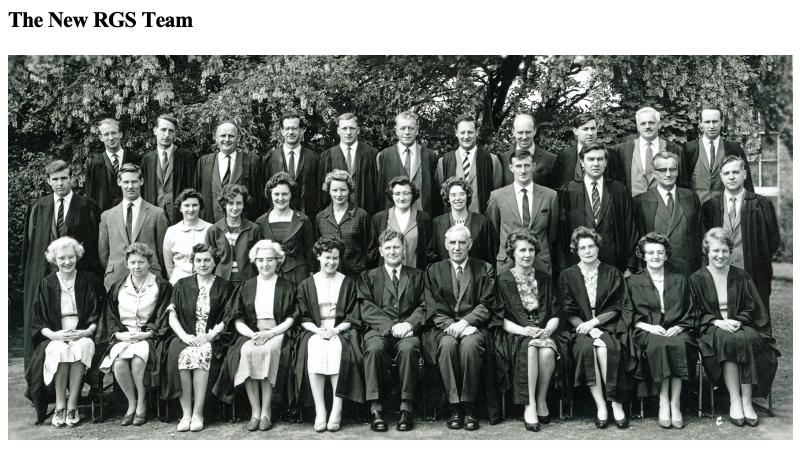
Extract from The Riponian magazine 1962 – 1963
The amalgamation of the grammar school and the high school meant that the staff of the school was increased to thirty full-time members. The masters of the grammar school were joined by the majority of the mistresses from the high school, and several newcomers were appointed to augment the facilities offered in the new school or to replace members of staff who had left or retired.
Miss C. Gilbey came from Ackworth School to take up the post of senior mistress and to be in charge of the new house for girl boarders, Johnson House.
Mrs. E. Illingworth joined the mathematics department, Miss C. M. Bentley joined the art department, and Miss R. Moore joined the geography department. Both Miss Moore and Miss Bentley became resident staff in Johnson House when it was occupied towards the end of the summer term.
Mr. J. H. Chambers became the first full-time woodwork master that the school has ever had. He was a resident master during the 1962-3 session but his marriage in the summer meant that he relinquished his boarding duties. Mr. Locke also relinquished his boarding duties, and for the same reason, at Easter.
Mrs. J. Beilby came as part-time assistant in the music department, and Mrs. P. Brown, who in the early part of the war became the first woman teacher in a boys' grammar school in Yorkshire, returned to the staff to help, part-time, with biology for one year. For the latter part of the year the school had Mlle. Roullier as French Assistante.
The full staff was:-
Headmaster: Mr. R. Atkinson;
Deputy Headmaster-Mr. J. H. Brown;
Senior Mistress- Miss C. Gilbey.
Mrs. W. Allinson, Miss E. Allison, Miss C. M. Bentley, Miss M. Craig, Miss J. Denton, Miss B. L. Holland, Miss M. T. Howstan, Mrs. E. Illingworth, Miss. R. Moore, Mrs. J. M. Naylor, Miss M. Phillips, Miss N. Wilkinson.
Mr. J W. Allinson, Mr. J. H. Chambers, Mr. S. Crawford, Mr. H. L. Eley, Mr. E. A. Kelsey, Mr. H. K. Locke, Mr. E. H. McKellow, Mr. P. H. Miles, Mr. W.J Petchey, Mr. J. D. Postlethwaite, Mr. T. H. Rowland, Mr. K. R. Simon, Mr. M. L. Temple, Mr. E. O'D Thomas, Mr. M. Wallace, Mr. B. Waters.
At the end of the summer term Mr. Temple left to take up an appointment at Bradford Grammar School. Mr. J. Bell was appointed in his place in the English department and Mr. D. Henderson was appointed as an additional biologist. Mr. Bell was educated at Ashby de la Zouch Grammar School and Downing College, Cambridge, and Mr. Henderson at Bede Grammar School Sunderland, and University College, Durham.
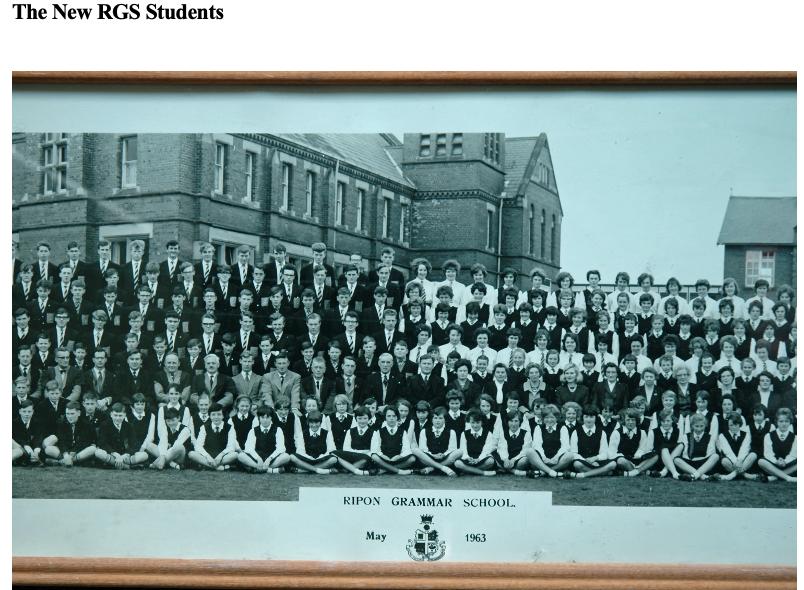
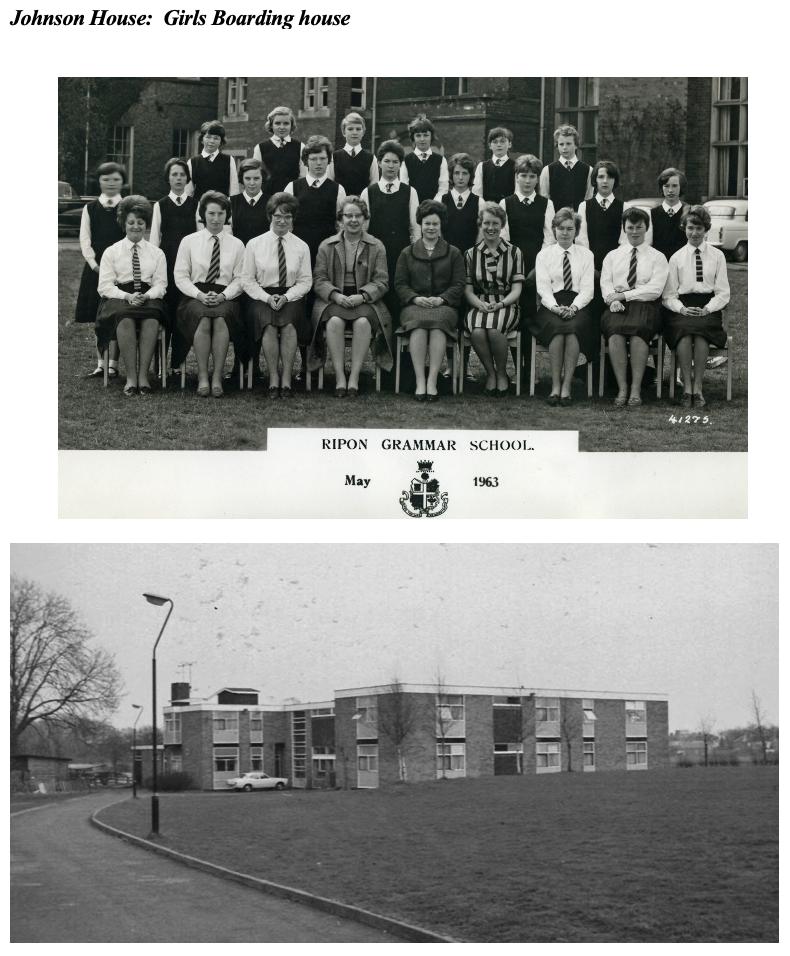
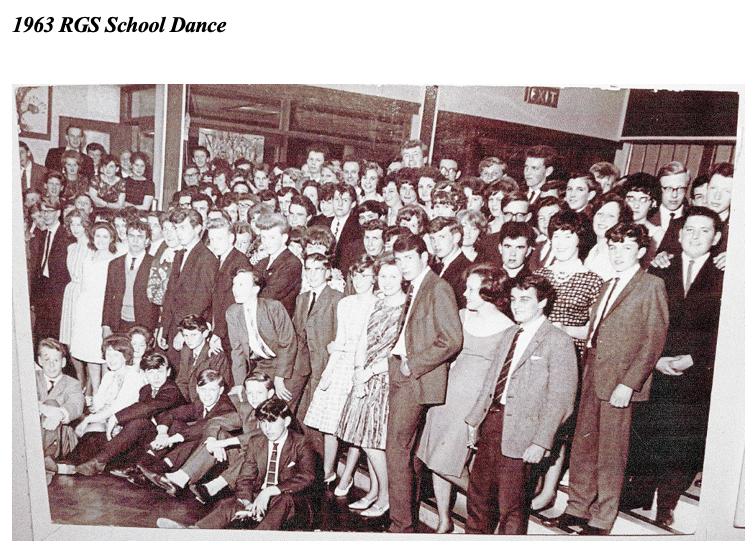
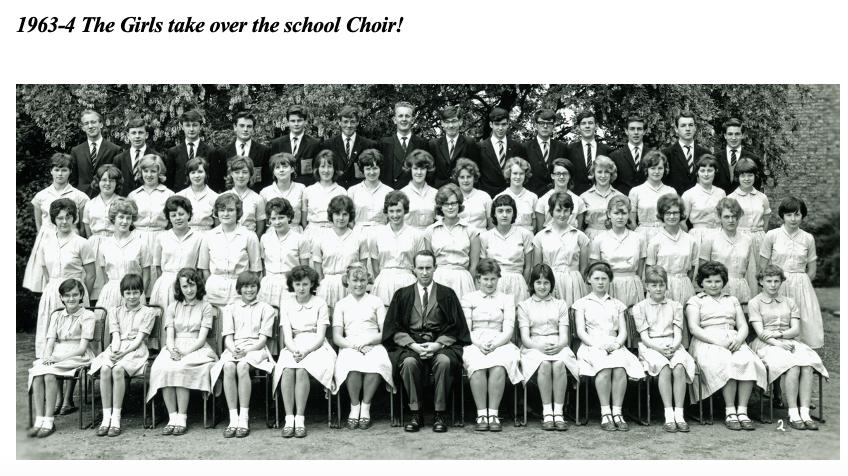
(These updated articles, below, come from the book published by RGS and the Old Riponians' Association to commemorate the 50th anniversary of the amalgamation. Thanks and credit to the original authors for their research)
The Early History of Ripon Girls' High School
Author Miss Jean Denton RGHS & RGS History Teacher 1953 -1982
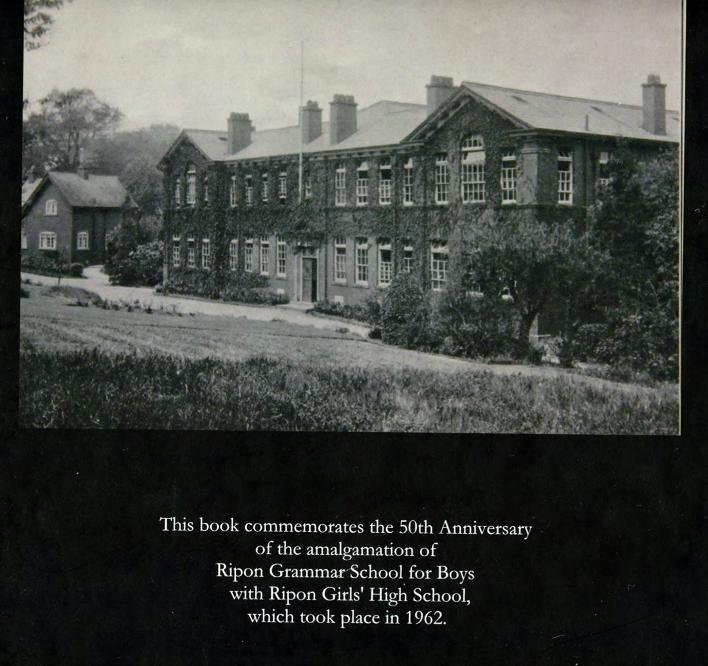
This early history is based substantially on the article written by Jean Denton in 2005 for The Ripon Historian, the magazine published by the Ripon Historical Society.
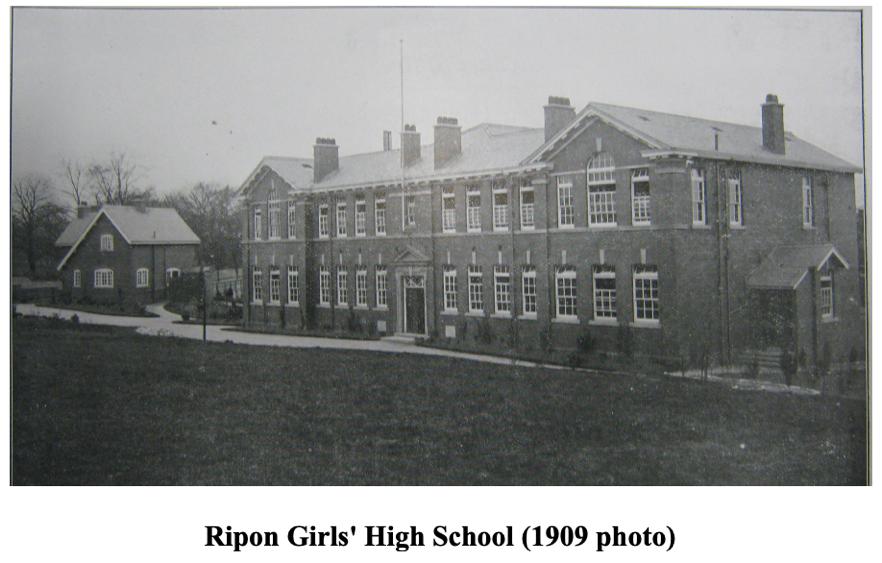
On January 22, 1909, twelve girls, ages ranging from nine to 14, arrived at a new building on Coltsgate Hill, Ripon, to be received by the governors of the school of which they were to be the first pupils. They were presented by Alderman W.T. Moss, the chairman of governors, with copies of John Ruskin's Sesame and Lilies as a memento of the occasion. It was fitting that Alderman Moss should preside over the ceremony as he had led the campaign for such a school to be built, against the opposition of large numbers of local people, who resented what they deemed an unnecessary burden on the rates, as secondary education for girls was regarded by them as unnecessary. For some time after the school was opened it was known by some as Moss's Folly.
So why had it happened just at that time? It was not until the Education Act of 1902 that public funds could legally be used to provide secondary education at all. Ripon had, of course, its ancient grammar school for boys established in Tudor times and endowed from the properties of the chantries dissolved by Henry VIII. In 1902 it had thus existed for nearly 350 years, but there were only small private schools for girls beyond the elementary school age.
However, in 1906 the West Riding County Council (WRCC), which covered Ripon at that time, included a secondary school for girls in Ripon in a list of proposed new schools in its area, and Ripon City Corporation felt obliged to agree to support such a school, the cost of which was estimated to be £7,500, about half of which it was said would be borne by the WRCC and the rest by local sources.
To secure plans for the building a competition was advertised in 1907 with a prize of £25 for the winner and £15 for the runner-up. Five sets of plans were received later that year and the winners of the competition were Messrs Conlon and Chorley of Leeds. The school was to accommodate 80 pupils and also evening technical classes which were to be transferred from the Mechanics Institute. Early in 1908 Messrs William Airey of Leeds were appointed building contractors with Mr. A.E. Huggan of Scarborough as Clerk of Works.
The new building was to have walls of brick from Middleton and local brickworks and a roof of dark Westmoreland slate. Heating was to be by hot water low pressure apparatus. The building was to consist of a basement and two storeys. The basement was to contain a manual instruction room. boiler room and bicycle room. The other storeys were of course to include the classrooms and staff rooms. There were to be five ordinary classrooms sufficient for 20 or 25 girls with special provision for art. cookery and laundry and a laboratory. The main hall was to be fined out as a gymnasium and there was to be a dining room for 24 girls and of course a cloakroom and toilets with an outside lavatory for the boys who came to the technical classes.
Tennis courts and a hockey pitch were to be provided and there was to be a separate caretaker's house.
On March 2, 1908 Alderman Moss cut the first sod on what was described in the local paper as 'a bright sunny but cold morning with a sprinkling of snow'. On March 30, he laid the foundation stone in a cavity in which the Mayoress placed a small metal box containing copies of the current week's issue of the Gazette and The Observer, the Yorkshire Post of Saturday, coins of the realm and photographs of the mayor and mayoress. Alderman Moss was presented with an ornamental mallet. On October 13 of the same year, a party was held at the Unicorn Hotel to celebrate the roofing of the school, which was eventually opened three months later.
The school was first known as Ripon Girls' Secondary School, but the name was soon changed to Ripon Girls' High School as the word 'secondary' was thought by some to be derogatory. The school badge, chosen a little later, was to show the Yorkshire rose and the Ripon horn with the words 'Veritas Summum Decus' ('Truth is the highest virtue').
Although the building was to be put up and maintained at public expense it was the understanding from the start that parents would pay fees for their daughters to attend this school. In 1908 it was suggested that these were likely to be about £6 (actually it was to be £6 15s when the school opened), but about £9 for pupils living outside the rated area. However, clever girls might be able to win a place in various ways. First to be arranged were scholarships under an approved adaptation of the Underwood Charity which had provided funds for teaching poor children to read and write since the 17th century. Three such exhibitions were publicised in 1908 and at the same time three for the grammar school. The county council also agreed to provide scholarships for pupils from the local elementary schools. These were later known as county minor scholarships and soon the governors elected three girls as governors' free scholars. Apart from the fees, parents would also be expected to provide books and what is described as 'other equipment'.
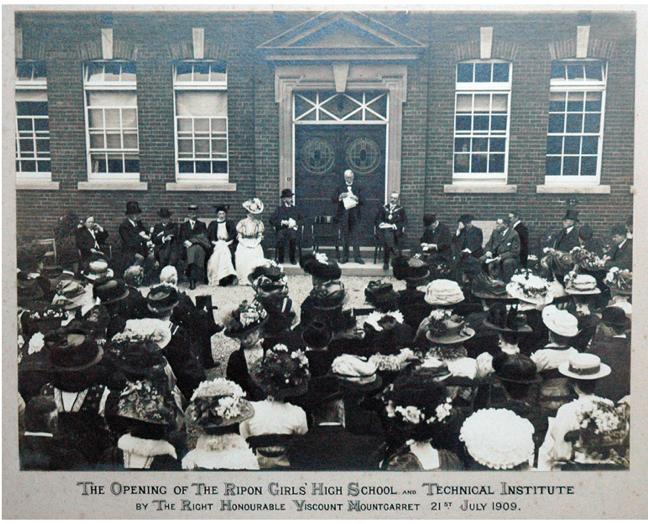

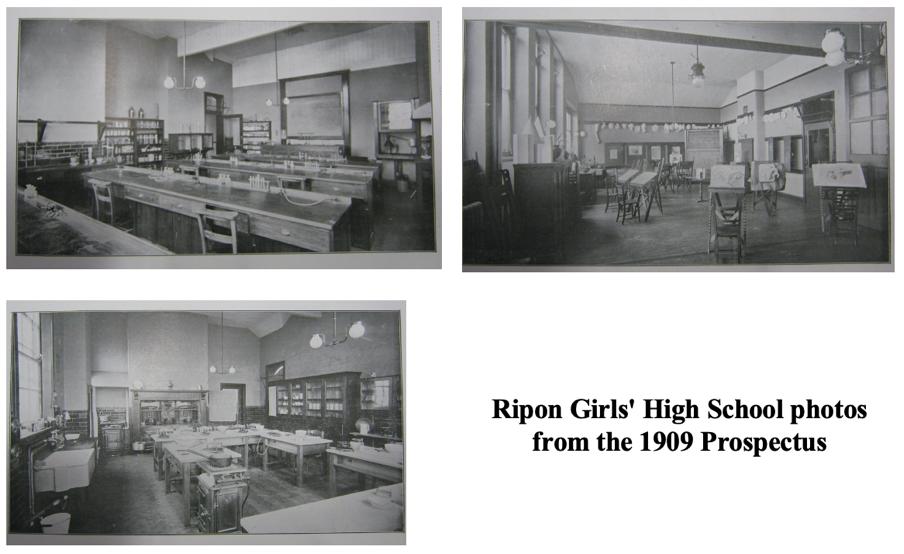
Arrangements for suitable staff for the school had begun in 1908 with an advertisement in the Journal of Education for a headmistress, salary £250 a year. Over 100 applications were received. Of these, eight were invited to come for interview but two more were subsequently added from late applicants, one of these two being the successful candidate. She was Miss Minnie Davie who for two years had been headmistress of Truro County School for Girls. She had been the first head of that school and no doubt that experience helped to get her the appointment in Ripon.
Shortly afterwards Miss M.S. Copland and Miss E. Prothero were appointed assistant mistresses at an annual salary of £110. These two with Miss Davie were the only full-time teaching staff. Miss Davie was to teach mathematics and some English; Miss Copland taught French, history, literature, and scripture. Miss Prothero taught elementary science, botany, geography, and some English. Miss Copland and Miss Prothero were also to share the teaching of needlework, games and drill, such an agglomeration of subjects being made necessary by the very small numbers of pupils expected in the first few years. Art and class singing were to be taught by two part time visiting staff. These were Miss Barker who came from Otley to teach art, and Miss M. Pearce, a Ripon music teacher, who provided class singing lessons. For a short time Swedish drill was taught by Herr Junker who was a Dane employed as instructor for the West Riding and based at Wakefield. In October 1909, cookery classes started under Miss Clapham. The first school caretaker was Mr. H.R. Benson formerly of Brewster Terrace.
The timetable for this first year consisted of four morning lessons in the more academic subjects with ten minutes drill and 15 minutes break in the middle. After a dinner break from 12.30 to 2.15pm the afternoon subjects, which took place in three lessons of varying length, were usually less academic-scripture, needlework, singing, cookery, drawing and games.
By the end of the opening year there were only 33 pupils, but these small numbers did not stop the school having its first speech day in December 1909, although this did not include the usual presenting of prizes, to which the headmistress was opposed. She also apparently disapproved of examinations. Her attitude led to some disagreement with the mayor and others although on this occasion the headmistress's view prevailed. Miss Davie's report was followed by an address by the Bishop of Ripon and then by a programme of music and recitation followed by a masque. The following year there were prizes presented by the bishop's wife.
The first account so far found of a sports day was that in 1912, which was said to have taken place on the tennis lawn at the back of the school. Beside the more usual obstacle, potato and slow bicycle races there was also one called the 'cloakroom' race. Prizes included books, brooches and an ink pot!
One of the 1909 pupils when interviewed by one of the sixth formers of 1962 had this to say about the school uniform in her time at the school. "Our parents had to provide us with a school hat - a hard straw boater, indoor slippers with low heels, white gym shoes and a drill costume consisting of a navy serge tunic, knickers reaching to the knees, long black stockings and a red blouse of cashmere or delaine. How hot they were! The second year we had white blouses for summer. The prescribed hair style was pig-tails one or two." The same pupil when asked about lunches said they could bring their own but excellent school lunches were provided at a cost of seven pence.
Another former pupil (1913-18) said that the red blouses were eventually changed to something lighter because the red came out in the wash. She also refers to wearing porkpie navy blue caps with badges in the winter and that they did not have uniform outdoor coats. "In fact" she says "one girl from Littlethorpe used to come in a fur coat"
But by the time this latter pupil entered the school there had been a number of other developments. In April 1910, an advertisement for the new term refers to the existence of a boarding house recognised by the governors (not the one to be opened later where the guest house called Box Tree Cottages now is). Then in 1912 the decision was reached to open a separate preparatory department for children under 10 and Miss E.G. Hawkins was appointed preparatory mistress.
There had also been considerable changes in the teaching staff. Miss Prothero resigned in 1910 and was succeeded by Miss M.E. Gray who taught mainly science subjects, and she in turn was replaced by Miss F.G. Wright in 1912. In that year Miss Copland left to be married to a member of the cathedral clergy. She was replaced by Miss M.I. Barnes. In 1910 Miss Smith replaced Miss Clapham for cookery. In 1913, when the art teacher from Otley found the strain of the journey too much for her and resigned, she was replaced by Miss E. Babington who was to prove the longest serving member of staff ever. She only retired in 1954.
But the most important early change of all had taken place in 1911 when Miss Davie, the headmistress, resigned, having been offered the headship of a bigger school in Bournemouth. Advertisements for the Ripon post led to 94 applications of which seven were selected for interview. The result was the appointment of Miss A.R. (Annie Romola) Piggott, a Newnham graduate whose degree was in modern languages, thus necessitating the appointment of a mathematics teacher, Miss Wilmott. Miss Piggott was half Italian and had had part of her education in Italy, and soon after her appointment in Ripon gave three lectures on 'The Making of Modern Italy'. Before her appointment in Ripon she had been doing coaching and secretarial work in Cambridge, and no evidence has been found of her teaching in a school before coming to the headship of Ripon Girls' High School. One of her pupils later wrote that she had 'a charming personality' and was 'loved by us all'. Her untimely death in 1915 'was a great sorrow to everyone'. One of her school houses was subsequently named Romola after her.
Miss Piggott's early death led to the appointment in 1916 of the third headmistress in seven years. This was Miss M.W. Johnson, and this time the governors were luckier. Miss Johnson was to remain a much respected headmistress for 33 years and so provided the school its much needed stability. Under her guidance the number of pupils grew gradually from 77 to 253 in 1947, at around which number it settled, providing sound secondary education for girls until its amalgamation with the grammar School in 1962.
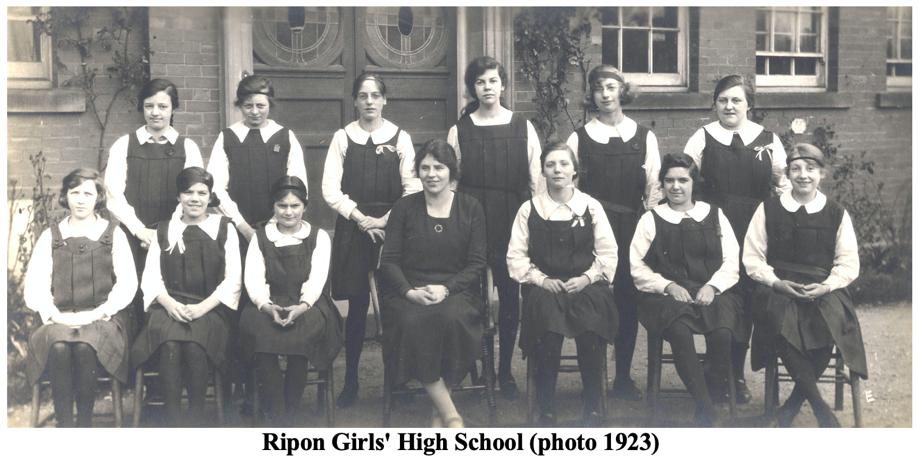
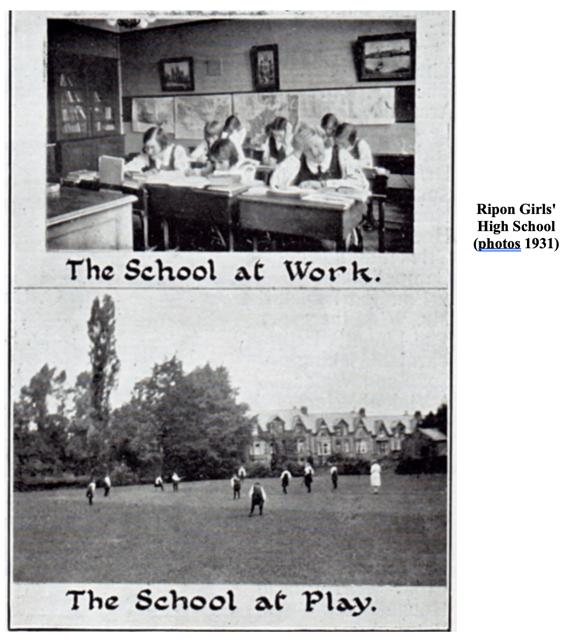
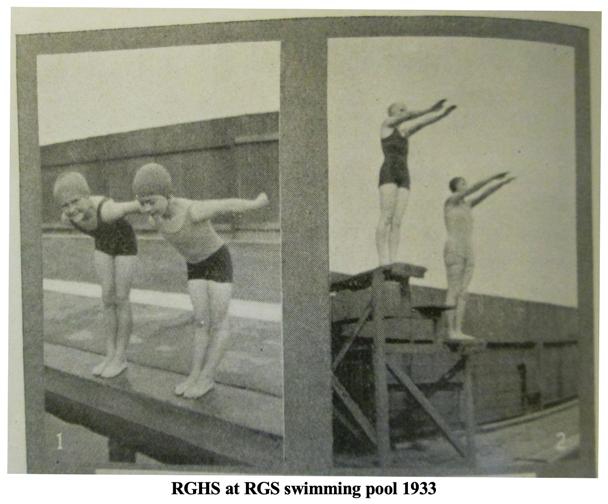
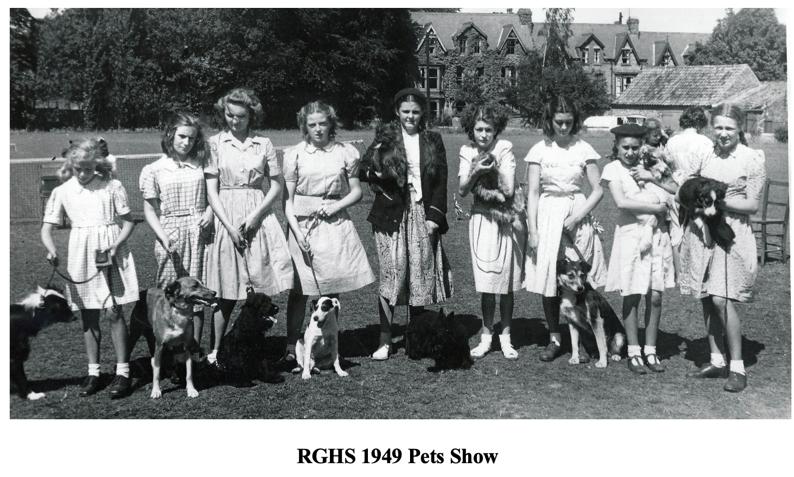
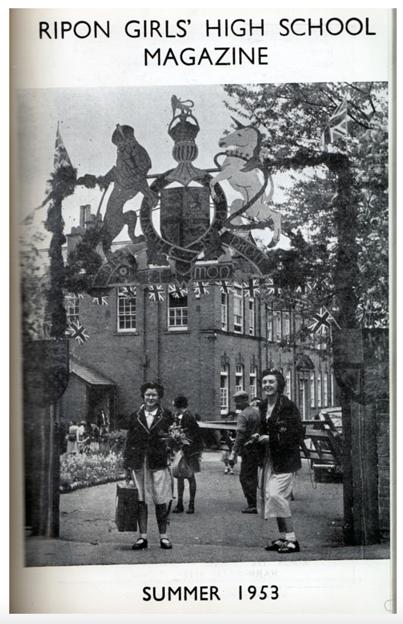
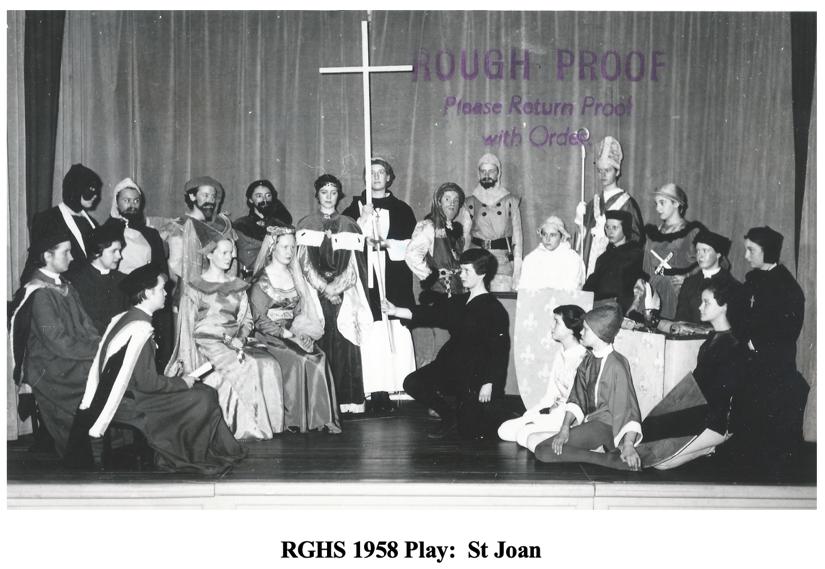
New century: Very sad news
